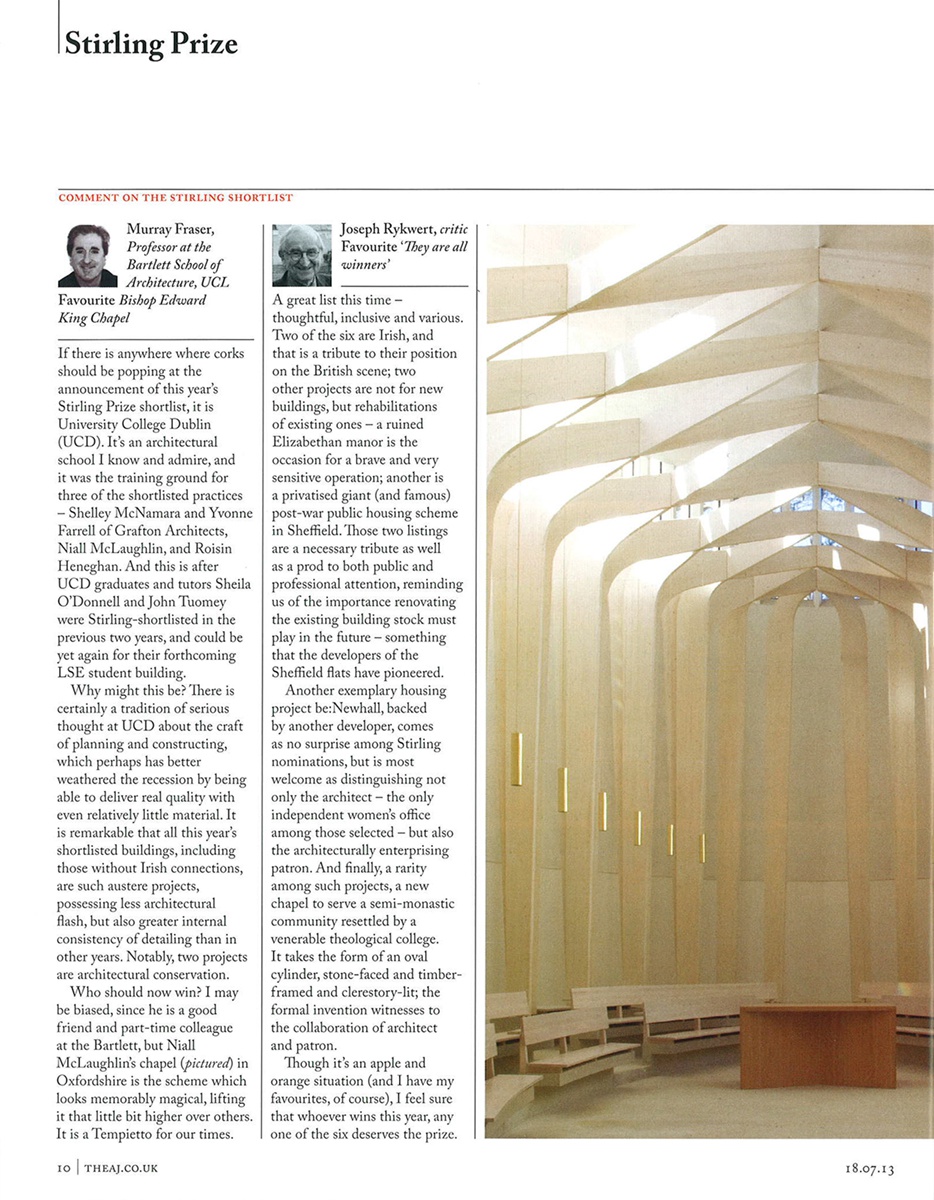Comment on the Stirling Prize Shortlist - Architects’ Journal
July 2013
Text Murray Fraser, Joseph Rykwert, Edwin Heathcote, Cathy Slessor
Images Dennis Gilbert
Murray Fraser, Professor at the Bartlett School of Architecture, UCL
Favourite – Bishop Edward King Chapel
If there is anywhere where corks should be popping at the announcement of this year’s Stirling Prize shortlist, it is University College Dublin (UCD). lt’s an architectural school I know and admire, and it was the training ground for three of the shortlisted practices – Shelley McNamara and Yvonne Farrell of Grafton Architects, Niall McLaughlin, and Roisin Heneghan. And this is after UCD graduates and tutors Sheila O’Donnell and John Tuomey were Stirling-shortlisted in the previous two years, and could be yet again for their forthcoming LSE student building.
Why might this be? There is certainly a tradition of serious thought at UCD about the craft of planning and constructing, which perhaps has better weathered the recession by being able to deliver real quality with even relatively little material. It is remarkable that all this year’s shortlisted buildings, including those without Irish connections, are such austere projects, possessing less architectural flash, but also greater internal consistency of detailing than in other years. Notably, two projects are architectural conservation.
Who should now win? I may be biased, since he is a good friend and part-time colleague at the Bartlett, but Níall McLaughlin’s chapel in Oxfordshire is the scheme which looks memorably magical, lifting it that little bit higher over others. It is a Tempietto for our times.
Joseph Rykwert, critic
Favourite – ‘They are all winners’
A great list this time – thoughtful, inclusive and various. Two of the six are Irish, and that is a tribute to their position on the British scene; two other projects are not for new buildings, but rehabilitations of existing ones – a ruined Elizabethan manor is the occasion for a brave and very sensitive operation; another is a privatised giant (and famous) post-war public housing scheme in Sheffield. Those two listings are a necessary tribute as well as a prod to both public and professional attention, reminding us of the importance renovating the existing building stock must play in the future – something that the developers of the Sheffield flats have pioneered.
Another exemplary housing project be: Newhall, backed by another developer, comes as no surprise among Stirling nominations, but is most welcome as distinguishing not only the architect – the only independent women’s office among those selected – but also the architecturally enterprising patron. And finally, a rarity among such projects, a new chapel to serve a semi-monastic community resettled by a venerable theological college. It takes the form of an oval cylinder, stone-faced and timberframed and clerestory-lit; the formal invention witnesses to the collaboration of architect and patron. Though it’s an apple and orange situation (and I have my favourites, of course), I feel sure that whoever wins this year, any one of the six deserves the prize.
Edwin Heathcote, architecture critic at the Financial Times
Favourite – Bishop Edward King Chapel
This has to be the lowest profile Stirling Prize shortlist for a decade. No blockbusters, no museums and not a single London building. It’s not bad though, the list mostly contains serious buildings by thoughtful architects, and there is a coolly refreshing lack of Hadid, Foster and Rogers.
It is extremely encouraging to see two re-use schemes (surely the future of architecture), Park Hill and Astley Castle, both of which have an almost medieval mass, albeit in radically different contexts. If there is a surprise it is a kind of midcentury revivalism. You can’t help seeing Louis Kahn in Grafton Architects’ project, Eero Saarinen in Bishop Edward King Chapel or a mid-century, cheery revivification of Park Hill’s original grey Brutalism.
There are some surprises. Hackett Hall McKnight’s MAC in Belfast isn’t here, although it was perhaps the most impressive building on the longlist and, despite myriad schools on this list, none have come through. Sometimes we find that a recession is good for the quality of architecture, filtering out the unnecessary headliners and pointless, over-engineered high-tech silly structures the Brits can’t seem to grow out of. But wouldn’t it have been good to see new social housing, public space and the rest? It all seems a bit disconnected; moments of quality, which I guess we should be grateful for. But remember, they are only moments.
Cathy Slessor, editor of the Architectural Review
Favourite – Bishop Edward King Chapel
No icons, no starchitects and no London projects. This year’s Stirling Prize shortlist is a paean to modest ambitions and unsung architects, but it also has a strong Irish inflection. Yet, as with all Stirling Prize shortlists, it is like trying to judge a volume of poetry against a cookery book, as former AJ editor Isabel Allen once remarked. The bookies’ favourite is Níall McLaughlin’s exquisite jewel box chapel in Oxfordshire, the most obviously and selfconsciously poetic project of the group, but Witherford Warson Mann Architects’ remodelling of Astley Castle is also a delicate and elegant piece of surgery. Compare these with the recasting of Park Hill by Hawkins\Brown and Studio Egret West, which reboots a Brutalise classic for the 21st century, and Alison Brooks’ be:Newhall, which celebrates the beauty of the ordinary and proves that housing can escape from the shackles of banality and pastiche.
You get the point. Equally, how do you fathom a solid, sober medical school by Grafton Architects, stars of the Venice Biennale, against Heneghan Peng’s riotously topographical Visitors’ Centre for the Giants Causeway, which might have been the clear home banker had the RIBA stuck to their original plan of staging the ceremony in Derry/Londonderry. So that leaves the most open field for years.The ‘could win’ is Hawkins\ Brown and Studio Egret West; and the ‘should win’ is Níall McLaughlin.
